Abstract
Due to the cutting-edge radius effect in micro-cutting, there exists some material sticking in front of the cutting-edge named stagnation zone, above which the material flows as chips. The location of the stagnation zone is reported to be associated with the minimum chip thickness in micro-cutting, which is a significant value influencing the cutting mechanics and the machined surface integrity in micro-cutting. The determination of the minimum chip thickness is of great importance in micro-cutting process. In this paper, the cutting force analysis on the shearing plane was carried out considering the ductile fracture and cutting-edge radius. Based on the cutting force analysis, this paper proposed a new method to determine the minimum chip thickness in micro-cutting of 18Ni maraging steel through finite element simulation. The minimum chip thickness was calculated to be 0.25 times the cutting-edge radius, which is in a good agreement with the velocity distribution analysis of the material around the cutting-edge. In addition, the effect of the plowing depth which was equivalent to the height of the stagnation zone on the residual stress filed was investigated using energy criterion. The energy stored in the machined surface increased with the plowing depth, resulting from the increasing thermal-mechanical load due to plowing.













Similar content being viewed by others
References
Vogler MP, Devor RE, Kapoor SG (2004) On the modeling and analysis of machining performance in micro-end milling, part I: surface generation[J]. J Manuf Sci Eng 126(4):695–705
Kim C-J, Rhett J, Ni J (2004) A static model of chip formation in microscale milling. J Manuf Sci Eng 126(4):710–718
Son SM, Han SL, Ahn JH (2005) Effects of the friction coefficient on the minimum cutting thickness in micro cutting. Int J Mach Tools Manuf 45(4–5):529–535
Mian AJ, Driver N, Mativenga PT (2011) Estimation of minimum chip thickness in micro-milling using acoustic emission. P I Mech Eng B-J Eng 225(9):1535–1551
Liu X, Devor RE, Kapoor SG (2006) An analytical model for the prediction of minimum chip thickness in micromachining. J Manuf Sci Eng 128(2):474–481
Liu K, Melkote SN (2005) Material strengthening mechanisms and their contribution to size effect in micro-cutting. J Manuf Sci Eng 128(3):1147–1156
Wu X, Li L, Zhao M, He N (2015) Experimental investigation of specific cutting energy and surface quality based on negative effective rake angle in micro turning. Int J Adv Manuf Tech 82(9–12):1941–1947
Nakayama K, Tamura K (1968) Size effect in metal cutting force. Int J Japan Soc Prec Eng 31(362):240–249
Atkins AG (2003) Modelling metal cutting using modern ductile fracture mechanics: quantitative explanations for some longstanding problems. Int J Mech Sci 45(2):373–396
Subbiah S, Melkote SN (2008) Effect of finite edge radius on ductile fracture ahead of the cutting tool edge in micro-cutting of Al2024-T3. Mater Sci Eng A 474(1–2):283–300
Karpat Y (2009) Investigation of the effect of cutting tool edge radius on material separation due to ductile fracture in machining. Int J Mech Sci 51(7):541–546
Parle D, Singh R, Joshi SS (2016) Fracture energy evaluation using J-integral in orthogonal micro-cutting. J Micro Nano-Manuf 4(1)
Li HN, Yang Y, Zhao YJ, Zhang ZL, Zhu WQ, Wang WL, Qi H (2019) On the periodicity of fixed-abrasive planetary lapping based on a generic model. J Manuf Process 44:271–287
Outeiro JC, Umbrello D, Saoubi RM (2006) Experimental and numerical modelling of the residual stresses induced in orthogonal cutting of AISI 316L steel. Int J Mach Tools Manuf 46(14):1786–1794
Su JC, Young KA, Srivatsa S, Morehouse JB, Liang SY (2013) Predictive modeling of machining residual stresses considering tool edge effects. Prod Eng 7(4):391–400
Grissa R, Zemzemi F, Fathallah R (2018) Three approaches for modeling residual stresses induced by orthogonal cutting of AISI316L. Int J Mech Sci 135:253–260
Johnson BE, Hoger A (1998) The use of strain energy to quantify the effect of residual stress on mechanical behavior. Math Mech Solids 3(4):447–470
Brinksmeier E, Klocke F, Lucca DA, Solter J, Meyer D (2014) Process signatures – a new approach to solve the inverse surface integrity problem in machining processes. Procedia CIRP 13:429–434
Ma Y, Feng P, Zhang J, Wu Z, Yu D (2015) Energy criteria for machining-induced residual stresses in face milling and their relation with cutting power. Int J Adv Manuf Technol 81(5–8):1023–1032
Yao Y, Zhu H, Huang C, Wang J, Zhang P, Yao P (2019) On the relations between the specific cutting energy and surface generation in micro-milling of maraging steel. Int J Adv Manuf Technol 104:585–598. https://doi.org/10.1007/s00170-019-03911-y
Zhai Y (2008) Research on mechanism of super-thin precision cutting and machined surface quality. Dissertation, Harbin Institute of Technology
Jakus AE, Fredenberg DA, Mccoy T, Thadhani NN, Cochran J (2012) Dynamic deformation and fragmentation response of maraging steel linear cellular alloy. AIP Conf Proc 1426:1363–1366
Connolly R, Rubenstein C (1968) The mechanics of continuous chip formation in orthogonal cutting. Int J Mach Tool Design Res 8(3):159–187
Williams JG, Patel Y, Blackman BRK (2010) A fracture mechanics analysis of cutting and machining. J Eng Frac Mech 77(2):293–308
Wang B, Liu Z, Yang Q (2013) Investigations of yield stress, fracture toughness, and energy distribution in high speed orthogonal cutting. Int J Mach Tools Manuf 73(1):1–8
M Malekian (2010) Investigation of micro milling processes. Dissertation, University of Galgary,
Nasr MNA, Ng EG, Elbestawi MA (2007) Modelling the effects of tool-edge radius on residual stresses when orthogonal cutting AISI 316L. Int J Mach Tools Manuf 47(2):401–411
Funding
This work is supported by the National Natural Science Foundation of China (51675312, U1708256).
Author information
Authors and Affiliations
Corresponding authors
Additional information
Publisher’s note
Springer Nature remains neutral with regard to jurisdictional claims in published maps and institutional affiliations.
Rights and permissions
About this article
Cite this article
Yao, Y., Zhu, H., Huang, C. et al. Determination of the minimum chip thickness and the effect of the plowing depth on the residual stress field in micro-cutting of 18 Ni maraging steel. Int J Adv Manuf Technol 106, 345–355 (2020). https://doi.org/10.1007/s00170-019-04439-x
Received:
Accepted:
Published:
Issue Date:
DOI: https://doi.org/10.1007/s00170-019-04439-x




